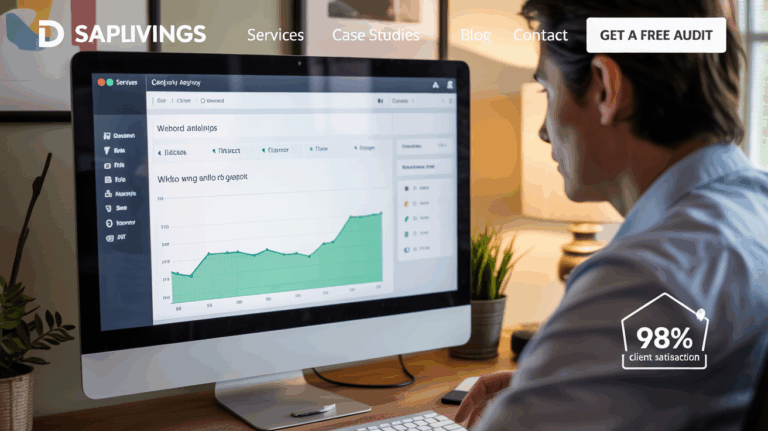The Future of SEO: AI, Voice Search & Search Intent in 2025
The Influence of Mobile-First Indexing
The swift rise of mobile devices has dramatically reshaped the way search engines determine content value. Enter mobile-first indexing—a game changer where search engines primarily lean on the mobile version of a site for both indexing and ranking purposes. This transition isn’t just a nod to evolving consumer habits; it underscores an urgent call for businesses to embrace mobile-friendly strategies if they want to stand out in the crowded digital arena. Websites that provide smooth, engaging experiences on mobile are not just favored—they’re more likely to soar in rankings, seizing the attention of an expanding wave of users who depend on their smartphones and tablets for all things online.
Crafting websites with a focus on mobile first means fine-tuning layout, speed, and user experience specifically tailored for those compact screens. Essential features like responsive design and lightning-fast loading times play pivotal roles in fostering user engagement and satisfaction. By placing emphasis on mobile usability, companies can boost their search engine standings while catering effectively to users who access their sites via handheld devices. As the significance of mobile-first indexing continues its ascent, adapting swiftly is crucial for preserving competitive edge in this ever-evolving digital landscape.
Optimizing Websites for Mobile Users
As our dependence on mobile devices for internet access skyrockets, a strategic rethink of web design and development emerges as essential. Websites must morph and shift with the fluidity of water, adapting effortlessly to an array of screen sizes and orientations—no two users are alike! Speed is everything; like lightning in a bottle, fast loading times are non-negotiable because today’s users demand instant gratification when seeking information.
An intuitive layout paired with crystal-clear navigation isn’t just nice to have—it’s vital! This allows visitors to glide through content with minimal effort, almost like navigating a well-charted map. Imagine incorporating touch-friendly interface elements that elevate usability on mobile platforms—a delightful experience awaits! Think larger buttons begging to be pressed and menus that appear at a mere swipe or tap, catering specifically to the distinctive quirks of mobile interaction.
And let’s not forget about content: brevity is key here. Long-winded text can send readers fleeing faster than you can say “scroll.” By honing in on these pivotal aspects, businesses can craft a dazzling mobile-optimized experience that not only meets consumer expectations but propels overall satisfaction into the stratosphere!
The Significance of Local SEO
Captivating local audiences has morphed into a crucial pillar of digital marketing strategies. In an era where consumers are on the hunt for businesses that meet their immediate desires, boasting a robust local SEO presence can dramatically amplify visibility. The art of optimizing for local search is all about fine-tuning content and weaving in geographic keywords—this clever maneuver allows businesses to soar to higher ranks in relevant searches. It’s not just about climbing the ranks; this laser-focused strategy bolsters organic traffic and forges more profound ties with the community.
Diving into local SEO practices can supercharge foot traffic and boost sales for brick-and-mortar shops. Being prominently visible on platforms like Google My Business means potential customers stumble upon precise information—think location, hours of operation, glowing customer reviews—all at their fingertips. By nurturing a strong local reputation, businesses don’t merely entice nearby shoppers; they cultivate trust, positioning themselves as go-to options within their neighborhoods.
Connecting with Consumers in Your Community
Grasping the intricacies of local consumer behavior is absolutely crucial for businesses eager to forge robust connections within their communities. Geographic targeting—ah, it’s a game changer! It empowers companies to customize their products and marketing strategies, directly addressing the whims and wishes of local folks. Tools like Google My Business? They’re not just handy; they can supercharge visibility while ramping up interactions with those customers right around the corner. Businesses that make local SEO a priority find themselves in prime positions during searches, making it a breeze for consumers to stumble upon them and lend their support.
Now, let’s talk about community involvement—it’s more than just participation; it cultivates trust and relatability! Organizations that dive into local events, throw their weight behind community initiatives, or champion neighborhood causes often reap the rewards in spades through heightened consumer loyalty. When businesses authentically engage with residents nearby, they don’t just become part of the scenery—they weave themselves into the very fabric of the community. This localized strategy doesn’t merely boost brand recognition; oh no! It sparks organic referrals and lures repeat customers back time after time.
Visual Search and Its Implications
The surge of visual search technology is upending the way consumers engage with online content, turning the digital landscape on its head. Imagine, instead of typing out queries in plain text, users can simply snap a picture or upload an image to find products and information—a paradigm shift that flips traditional search engine optimization into something altogether new and dynamic! As giants like Google and Pinterest ramp up their visual search features, businesses face an urgent need to recalibrate their strategies; optimizing for image recognition algorithms becomes paramount. This means ensuring that every piece of visual content shines in quality and is meticulously tagged—because only then can search engines navigate this rich tapestry of images successfully.
Integrating captivating visuals into marketing campaigns isn’t just beneficial; it’s imperative for grabbing user attention amidst the noise. Brands must channel creativity to craft eye-catching materials that truly resonate with their target audiences—think vibrant graphics or striking videos! By harnessing platforms where imagery reigns supreme—like Instagram and TikTok—businesses tap directly into consumer habits at their most active moments. Moreover, employing techniques such as schema markup not only bolsters image discoverability but also enhances visibility in crowded search results. When brands emphasize stunning visuals across every digital interaction point, they create a richly immersive experience that not only drives engagement but cements brand loyalty deep within the hearts (and feeds) of consumers!
Integrating Visual Content for Better Engagement
Harnessing the power of visual content can dramatically amplify user engagement across websites. Imagine this: high-quality images, vibrant infographics, and compelling videos coalescing into a dynamic tapestry that snags attention far more effectively than mere text could ever hope to do. This brilliant integration not only caters to various learning styles but also empowers users to digest complex information with astonishing speed. However, there’s a caveat—optimizing these elements for swift loading and accessibility is paramount; slow media can send potential visitors fleeing and gnaw at overall satisfaction.
Moreover, let’s not overlook the pivotal role visual content plays in the realm of search engine optimization. In today’s digital landscape, algorithms are increasingly favoring sites rich in media because metrics like time-on-page and interaction rates surge when visuals are involved. Incorporating alt text and relevant metadata isn’t just helpful—it’s essential for enhancing both accessibility and discoverability. Brands that masterfully wield visual content cultivate deeper connections with their audiences, ultimately leading to elevated retention rates—and who knows? Perhaps even boosting conversions along the way!
| Type of Visual Content | Engagement Benefits | Optimization Tips |
|---|---|---|
| High-Quality Images | Captures attention, supports storytelling | Use compressed formats (e.g., JPEG, WebP) |
| Infographics | Simplifies complex information, increases shareability | Ensure clarity by using concise data, and attractive layouts |
| Videos | Enhances engagement, boosts time-on-page | Employ efficient coding practices and use streaming services to minimize load times |
| Animations | Adds interactivity, holds user attention | Keep file sizes small and consider user experience to avoid distractions |
The Future of Link Building
As search engine algorithms twist and turn in their relentless evolution, so too will the link-building tactics that organizations deploy—an ever-shifting dance of strategy. The bedrock remains: high-quality backlinks from reputable sources are vital for bolstering domain authority and enhancing visibility in the digital ether. Yet, here’s where it gets interesting—the spotlight is shifting! Relevance and context are taking precedence over mere numbers, a subtle but profound transformation.
Picture this: businesses weaving intricate relationships with industry influencers, engaging in meaningful collaborations around top-notch content. This isn’t just a trend; it’s a pathway to results that linger longer—a sustainable impact rather than fleeting gains.
But wait—there’s more! Enter artificial intelligence, stepping onto the scene like an eager assistant ready to revolutionize link-building endeavors. These AI marvels can sift through mountains of data at lightning speed, pinpointing linking opportunities shaped by audience behavior and interests. Imagine marketers armed with insights capable of crafting laser-focused outreach campaigns tailored to specific demographics—a symphony of precision!
As competition tightens its grip on the landscape, one truth emerges clearly: forging genuine connections and producing content laden with value will be paramount for snagging those coveted quality backlinks. The game is evolving; let’s play smart!
Evolving Strategies for Acquiring Quality Backlinks
Securing quality backlinks is still a cornerstone of search engine optimization, but oh, how the landscape has morphed! With algorithms evolving into intricate webs of complexity, the spotlight now shines brightly on not just sheer numbers but the caliber and relevance of those links. Crafting content that speaks to specific user needs? That’s your golden ticket to attracting organic backlinks. And let’s not overlook guest blogging or teaming up with influencers—these strategies amplify visibility and bolster credibility, paving the way for link-building efforts that feel authentic rather than contrived.
But wait! The horizon gleams with potential as emerging technologies open fresh pathways for backlink acquisition. Imagine harnessing artificial intelligence tools capable of dissecting competitor backlink profiles—suddenly, high-value sources for outreach are laid bare before you. Coupled with savvy data analytics that illuminate which content truly resonates with target audiences, businesses can embark on more strategic link-building campaigns. By nurturing real relationships within their industries—not just transactional ties—brands can forge a sustainable backlink strategy harmonizing perfectly with both user intent and what search engines crave.
- Invest in high-quality content creation to naturally attract backlinks.
- Utilize AI tools to analyze competitor backlinks for new opportunities.
- Implement data analytics to understand which content performs best with audiences.
- Engage in guest blogging to share expertise while building quality links.
- Collaborate with influencers to expand your brand’s reach and credibility.
- Foster genuine relationships within your industry to enhance backlinking efforts.
- Continuously monitor and adapt strategies to align with evolving search engine algorithms.
Ethical Considerations in SEO Practices
The whirlwind of change within the digital marketing realm spins a web of ethical dilemmas for SEO professionals. With artificial intelligence tools advancing at breakneck speed, critical issues like data privacy, user consent, and transparency burst into prominence. Yet, employing AI to sharpen search strategies must never jeopardize consumer trust—this is non-negotiable! Marketers are called to elevate their game by weaving in ethical practices that honor user privacy while deftly navigating their business goals.
On another front looms a troubling trend: the rise of misleading tactics—think clickbait and covert content—that threaten the very fabric of online integrity. Upholding ethical standards in SEO isn’t just an option; it’s imperative! This commitment demands delivering authentic value to users—a mission that involves crafting high-quality, relevant content designed not only to satisfy search engine algorithms but also to genuinely serve audience needs. By nurturing an atmosphere steeped in trust and accountability, businesses can forge enduring connections with consumers—even amid fierce competition in the sprawling digital marketplace.
Maintaining Integrity in AI and Marketing Approaches
The whirlwind of AI advancements in the realm of digital marketing is nothing short of stunning, sparking an urgent need for unwavering ethical standards. Companies must shine a spotlight on transparency regarding their use of AI to collect and process data—it’s not just good business; it’s a moral imperative. The stakes are high: algorithms mustn’t reinforce biases or trample on user privacy, but rather navigate these treacherous waters with care and consideration. Embracing responsible AI practices isn’t merely about compliance; it’s a pathway to cultivating trust with consumers while simultaneously bolstering brand credibility.
Yet, weaving integrity into marketing strategies demands a delicate dance—a balancing act between harnessing automation’s power and retaining that essential human touch. Sure, automated tools can slice through campaigns like a hot knife through butter, analyzing consumer patterns at lightning speed. But without the guiding hand of human insight, messaging risks becoming soulless drivel that fails to connect deeply with audiences. Authenticity in content creation isn’t just a buzzword—it’s the glue that binds customer relationships tighter than ever before while answering the clarion call for ethical marketing in this tech-fueled era we find ourselves navigating.
Conclusion
The digital landscape is a whirlwind of change, morphing at breakneck speed and redefining the very essence of search engine optimization. With each technological leap forward, marketers find themselves in a race to decipher user behavior—especially as artificial intelligence and voice search burst onto the scene like a fireworks display illuminating the night sky. Crafting adaptable strategies that prioritize mobile-first indexing and local SEO isn’t just smart; it’s essential for businesses striving to forge meaningful connections with their target audience.
In this chaotic environment, championing ethical practices in SEO emerges as a beacon of trust and credibility within the industry’s ever-shifting sands. And let’s not overlook visual search, which is gaining steam faster than you can blink! By weaving captivating visual content into the fabric of marketing efforts, brands can significantly amplify user engagement—a crucial factor in today’s attention-deficit world. Embracing these emerging trends doesn’t merely enhance marketing tactics; it paves the way for a more informed—and yes, responsible—approach to navigating the vast seas of digital marketing.
FAQS
What is the significance of mobile-first indexing in SEO?
Ah, mobile-first indexing! A paradigm shift where search engines now predominantly gaze upon the mobile version of your website when deciding its fate in the ranking hierarchy. This reality screams for a transformation—websites must be finely tuned for those on-the-go users if they wish to bask in the limelight of search results and reap the rewards of enhanced visibility.
How can businesses optimize their websites for mobile users effectively?
The art of optimizing a website for those nimble-fingered, smartphone-wielding patrons lies in several clever strategies. Think responsive design that adapts like water, turbocharging page load speeds to keep impatience at bay, crafting navigation so simple it feels intuitive, and ensuring that vital content doesn’t play hide-and-seek on smaller screens.
Why is local SEO important for businesses?
Local SEO holds immense importance—it’s like a beacon guiding nearby consumers straight into your arms. By honing this strategy, businesses amplify their presence in localized searches, igniting foot traffic and kindling deeper engagement from potential customers right around the corner.
What role does visual search play in the future of SEO?
Enter visual search—a revolutionary approach where images become keys instead of mere accompaniments to text! Businesses must embrace this trend by weaving high-quality visuals into their fabric; optimizing images with thoughtful tags becomes crucial while curating an engaging tapestry that enriches user experience beyond imagination.
What are the evolving strategies for link building in SEO?
Link building strategies are morphing before our very eyes! It’s no longer just about quantity but quality—cultivating valuable backlinks through compelling content marketing narratives or guest blogging escapades. Partnerships flourish here too! Social media serves as fertile ground while relevance reigns supreme; every link should weave value into both linked entities’ stories.
What ethical considerations should be taken into account in SEO practices?
Ethical dimensions loom large over SEO practices—transparency with users isn’t just nice; it’s essential. Steering clear from manipulative tactics like black hat methods ensures integrity remains intact. Aligning marketing endeavors with authentic consumer interests respects privacy rights while adhering to data protection regulations creates trust—a priceless commodity today.







